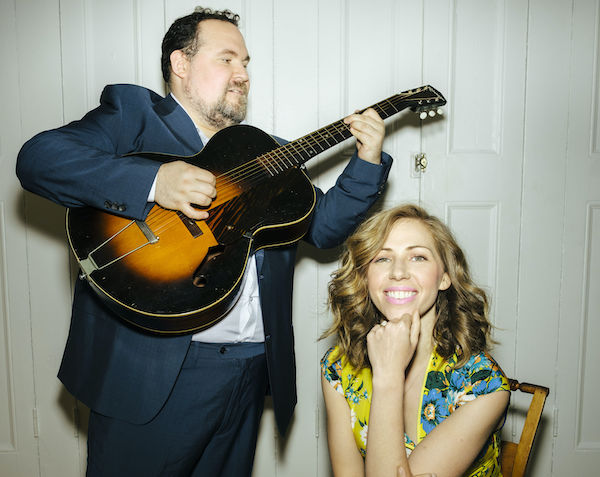Oct 28, 2025 10:47 AM
In Memoriam: Jack DeJohnette, 1942–2025
Jack DeJohnette, a bold and resourceful drummer and NEA Jazz Master who forged a unique vocabulary on the kit over his…

Rachael Price (right) of the band Lake Street Dive teamed up with Vilray for a new duo album.
(Photo: Jonno Rattman)Artists compulsively find new ways of bridging past and present. On their debut album, Rachael & Vilray (Nonesuch), singer Rachael Price and guitarist, singer and composer Vilray proffer a way of connecting not-quite-the-past with not-quite-the-present, resulting in a timeless quality.
“We were trying to avoid sounding like a jazz album from today,” said Vilray, “but also trying to avoid sounding like a jazz record from the ’30s.”
Vilray, who composed the 10 original tunes on the 12-track recording, mined repertoire of the 1930s through the late ’50s for inspiration; despite its referencing different eras, he and Price aimed for cohesion. “It all feels like it’s part of the same record,” he said. “It’s got a vibe from top to bottom.” Rachael & Vilray includes an appearance from pianist Jon Batiste and horn-section arrangements from saxophonist/clarinetist Jacob Rex Zimmerman.
Price and Vilray, who met as students at New England Conservatory, achieved the sweet spot for their sound working with engineer Dan Knobler. He secured a tight room where the artists could play all together, recording only a couple takes per tune. From the outset, the duo rejected the notion of recording a “nostalgia album,” according to Price, who serves as lead vocalist for NEC-born rock band Lake Street Dive. “It also can’t sound super-modern, because that would be too jarring,” Vilray said. “It’s a fine balance.”
The artists themselves struck a balance that reflects give-and-take during the creative process, a departure from Price’s more open-ended process with Lake Street Dive. “This band is kind of a different thing,” she said. She cites an example of their push-pull dynamic on a tune Vilray had written with Fats Waller’s vocal in mind. Price chose to channel someone else’s.
“I wanted to be more like Doris Day because I don’t sing like Fats Waller,” she said. “That’s not somebody I would try to emulate.” In that way, Price feels she turned the creative challenge back on her partner, who received her interpretation and responded.
A more personal challenge for Price was embodying the essence of a singer’s individual contributions without imitating their sound. “I try to picture the energy that they were feeling when they were [recording] for the first time,” she said. “They were probably going into the studio and producing sounds that were new to them. So, it’s important to me to make sounds that feel new to me.”
Vilray’s desire to compose music that could serve singers from past eras compelled him to write new lyrics that referenced starched collars and the Lindy Hop. But as much as he might have sought to exclude lyrics that reflect the current era, he can’t escape his own experiences. Though not explicitly stated, a powerful topic pervades “Alone At Last,” one that hadn’t held much of a thematic spotlight during the ’30s: social anxiety.
While he asserts anxiety and panic disorders have existed long before they received an entry in the DSM, Vilray admitted few pre-war lyricists likely wrote about them the way he does. “That’s a very different song, in terms of the writing,” he said. “That was an ‘of my life’ love song. I wasn’t writing that for anybody else. Probably, the word ‘agoraphobic’ wasn’t on everybody’s lips [in a previous era], but I was still trying to think of it in terms of timelessness.”
For the duo, its not-quite-current, not-quite-vintage intention proved both challenging and truly rewarding. “I don’t think I was expecting people to like it that much,” Price said, laughing. “This is the music that I love. When we started doing it together, I really just envisioned it as something I was doing for myself, and I’d found a person who loved it as much as I did.” DB

Jack DeJohnette boasted a musical resume that was as long as it was fearsome.
Oct 28, 2025 10:47 AM
Jack DeJohnette, a bold and resourceful drummer and NEA Jazz Master who forged a unique vocabulary on the kit over his…

D’Angelo achieved commercial and critical success experimenting with a fusion of jazz, funk, soul, R&B and hip-hop.
Oct 14, 2025 1:47 PM
D’Angelo, a Grammy-winning R&B and neo-soul singer, guitarist and pianist who exerted a profound influence on 21st…

Kandace Springs channeled Shirley Horn’s deliberate phrasing and sublime self-accompaniment during her set at this year’s Pittsburgh International Jazz Festival.
Sep 30, 2025 12:28 PM
Janis Burley, the Pittsburgh International Jazz Festival’s founder and artistic director, did not, as might be…

Jim McNeely’s singular body of work had a profound and lasting influence on many of today’s top jazz composers in the U.S. and in Europe.
Oct 7, 2025 3:40 PM
Pianist Jim McNeely, one of the most distinguished large ensemble jazz composers of his generation, died Sept. 26 at…

Drummond was cherished by generations of mainstream jazz listeners and bandleaders for his authoritative tonal presence, a defining quality of his style most apparent when he played his instrument unamplified.
Nov 4, 2025 11:39 AM
Ray Drummond, a first-call bassist who appeared on hundreds of albums as a sideman for some of the top names in jazz…